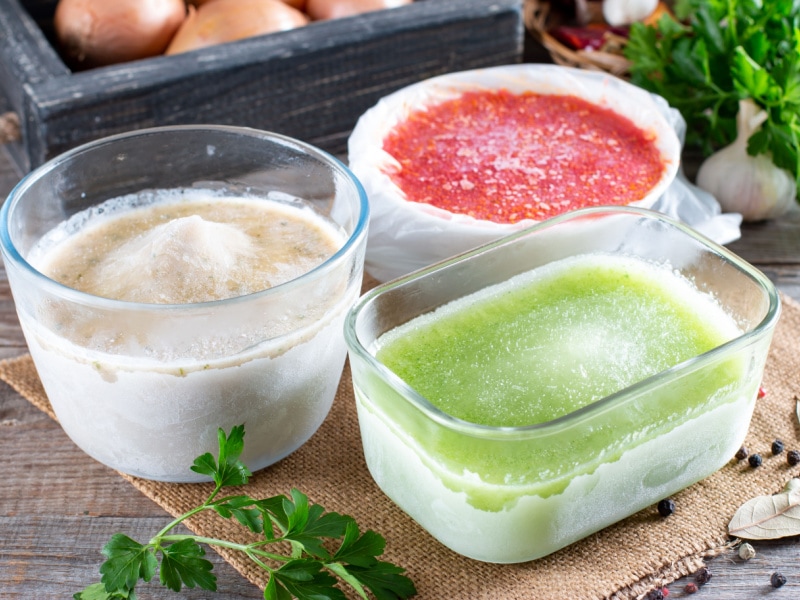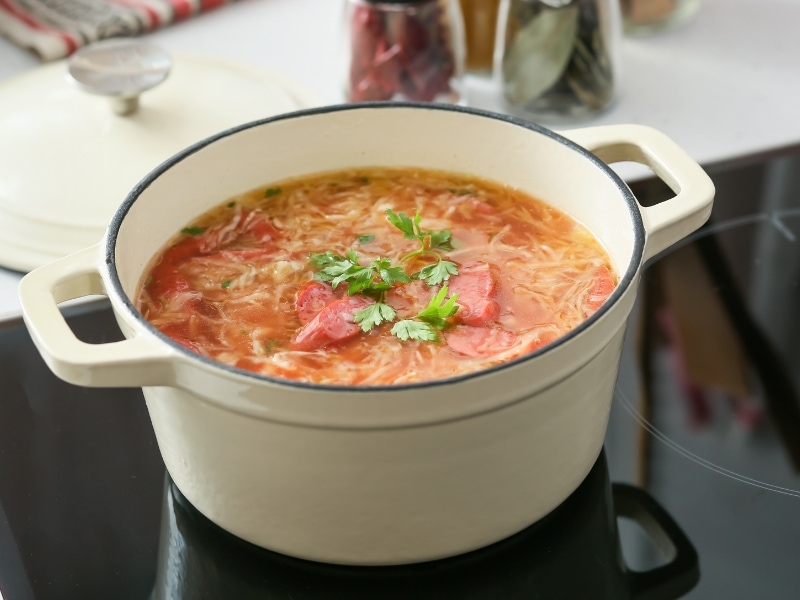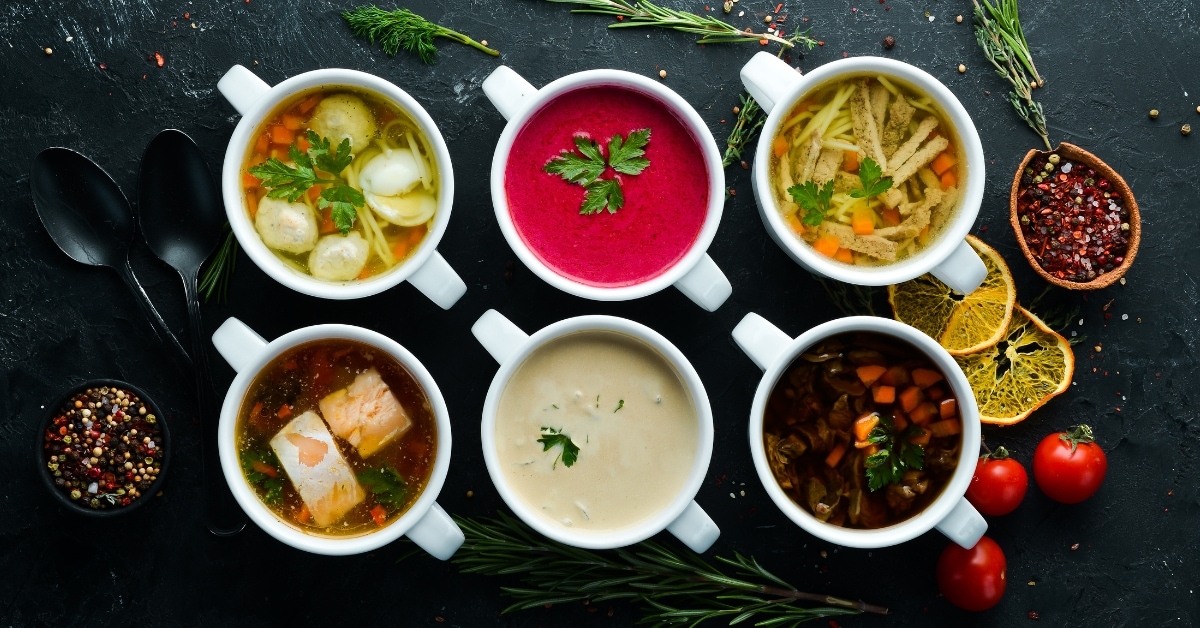If you’re tired of tossing out your leftover soup, it’s time to learn how to freeze soup like a pro!
Are you always wondering what to do with those leftover soup batches you made? Or maybe you just want to meal prep like a pro?

Freezing your soup is your new best friend! It’s a super easy and convenient way to enjoy your favorite hearty meal anytime you want!
Follow these easy steps, and you’ll be able to enjoy a warm bowl of soup anytime you want.
What Types of Soup Can You Freeze?
When it comes to freezing soup, not all recipes are created equal.
Some soups are simply born to be frozen, while others might need a little extra care and attention.
Broth-based soups: Brothy soups loaded with hearty vegetables and proteins are great for freezing.
These soups hold up well in the freezer and taste just as fantastic when reheated.
Soups with dairy: Dairy products like cream, milk, and cheese can sometimes curdle when frozen and reheated.
If your heart is set on freezing a creamy soup, try making it without the dairy elements (cream, roux, cheese, etc.).
Freeze it as a broth-based soup instead.
When you’re ready to serve, thaw and reheat the soup, then add the creamy components just before eating.
Soups with noodles: Chicken noodle soup is an all-time classic, but freezing it with noodles can be a bit of a gamble.
Noodles tend to absorb moisture and can become mushy during freezing and thawing.
To avoid a noodle disaster, prep your soup recipe as usual, but leave the noodles out before freezing.
When it’s time to enjoy your soup, simply thaw and reheat the base.
Then, cook the noodles separately and combine them just before serving.
This way, your noodles will stay perfectly al dente.

How to Freeze Soup
Now that you know which soups are freezer-friendly, let’s dive into the freezing process!
Follow these simple steps to ensure your soup stays fresh and delicious:
- Cool it down: Allow your soup to cool to room temperature before freezing. This helps prevent bacterial growth and protects the quality and flavor of your soup.
To speed up the cooling process, you can transfer the soup to a shallow container, occasionally stirring to release heat.
Just be sure not to leave your soup at room temperature for more than two hours to ensure food safety.
- Portion it out: Divide your soup into individual servings or family-sized portions to make mealtime a breeze.
That way, you can grab exactly what you need, reducing waste and saving time on thawing and reheating.
- Leave some space: When filling your containers or bags, be sure to leave a little room at the top to accommodate the soup’s expansion as it freezes.
This extra space will help prevent spills and potential messes in your freezer. As a general rule, leave about 1/2 to 1 inch of headspace.
- Seal it tight: Use air-tight containers or heavy-duty freezer bags to keep your soup fresh and free from freezer burn.
When using freezer bags, try to remove as much air as possible before sealing.
You can do this by squeezing the air out manually or using a straw.
- Label and date: Don’t forget to label your containers or bags with the type of soup and the date it was prepared.
This way, you’ll easily know what’s inside and how long it’s been in the freezer.
You can use a permanent marker or freezer-safe labels to ensure the writing doesn’t fade or smudge over time.

How Long Can You Freeze Soup?
You can freeze soup for up to three months. But remember, the longer it’s in there, the less fresh it’ll taste.
Over time, ice crystals might form, and when thawed, the flavors might be a bit diluted.
Meat-based soups can chill in the fridge for up to four days. To be on the safe side, freeze them within three days of cooking.
Try and freeze all soups the same day you make them.
Creamy soups might not taste as great after freezing because their texture can change.
Rice, bean, and noodle soups might taste a bit different too.
Usually, broth-based soups are your best bet for freezing and enjoying later.
Best Containers for Freezing Soup
Choosing the best container for freezing soup is all about your eating plans, freezer space, and what you have lying around.
Tight on space or into freezing single servings? Air-tight freezer bags are your new best friend.
Just pour your soup into the bag, squish out any extra air, and seal it up.
Now, you need to freeze it flat. That way, you can lay it directly on your freezer’s “floor,” or put it on a baking sheet.
Or, you can nestle it in a plastic container before sliding it into the freezer.
Once frozen, stack them up or line them up like books on a shelf.
Don’t skimp on quality. Go for top-of-the-line freezer bags.
They’re thicker and tougher than your everyday sandwich bags.
Worried about leaks? Just keep the soup on the baking sheet or inside the plastic container while it freezes.

Which Soups Are Best for Freezing?
While most soups can be frozen, some are definitely better suited for the freezer than others.
Here are a few types of soups that freeze particularly well:
Soups made with beans, like black bean, lentil, or chickpea, are great for freezing.
The beans retain their texture and flavor, making these soups perfect for reheating.
Chicken noodle, vegetable, and minestrone are just a few examples of broth-based soups that freeze well.
The flavors meld together as the soup sits, so they often taste even better after being frozen and reheated.
Hearty soups with meat, like beef stew or chicken and rice, hold up well in the freezer.
The meat maintains its texture and the flavors intensify over time.
Whether it’s a classic beef chili or a vegetarian version, chili is also a freezer superstar.
Soups with a high dairy content or delicate ingredients, like seafood, may not freeze as well.
But you can always add these ingredients after thawing and reheating.
How to Thaw Frozen Soup
When you need to thaw food, put the frozen bag in a container and place it in the fridge.
It won’t leak, but the food can lose shape, so it’s best to keep it contained.
Thin bags help the food thaw fast, usually overnight or during work hours.
For a quick thaw, microwave the food in its plastic bag on a plate.
When it’s soft enough to break apart or remove from the bag, put it in a bowl to finish microwaving.

How to Reheat Soup
Once your soup is thawed, it’s time to reheat and enjoy! Here are three convenient ways to reheat your soup:
Microwave:
- Transfer your thawed soup to a microwave-safe container, cover it with a microwave-safe lid or plate, and heat on high for 2-3 minutes.
- Stir the soup, then continue heating it in 1-minute increments until it’s heated through.
Stovetop:
- Pour your thawed soup into a saucepan and heat it over medium heat, stirring occasionally.
- Once the soup starts to simmer, reduce the heat to low and continue to cook it until heated through.
Instant Pot:
- Pour your thawed soup into the Instant Pot and set it to medium heat.
- Cook the soup for 5-10 minutes, or until it’s hot enough. Remember to stir it now and then.









